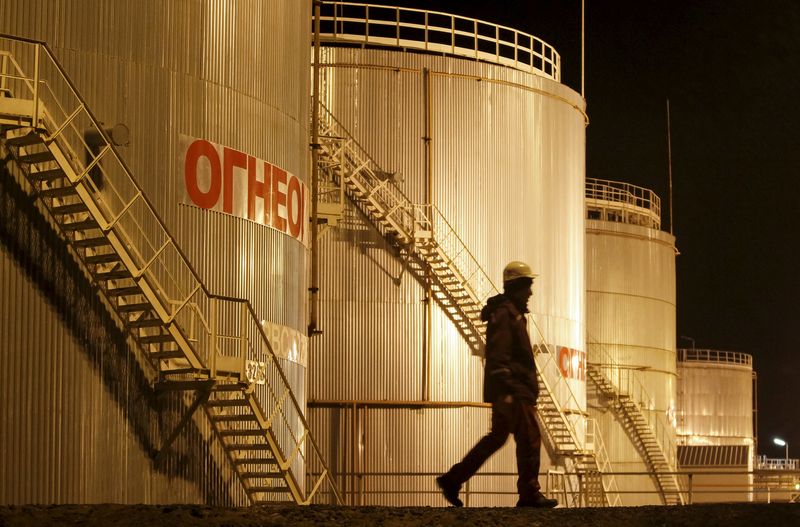(Bloomberg) -- The prospect of a deal between OPEC and its allies to increase output is forcing oil traders to grapple with an unfamiliar concept: Russian spare production capacity.
Thanks to its unprecedented cooperation with OPEC to cut production, Russia has deliberately idled oil wells for the first time in its history. It’s joined the ranks of OPEC’s swing producers such as Saudi Arabia or Kuwait, but judging exactly how much Russia can boost its output, and how quickly, is a much more difficult task.
The answer could help determine how rapidly the OPEC+ coalition reverses its output cuts, and the extent of their impact on crude prices.
The size of Russia’s spare capacity has "become a critical question affecting the stability of global oil markets," according to IHS Inc. "This is new territory for them, they’ve never had production that has been deliberately held back," said Matthew Sagers, managing director of Russian and Caspian energy research at the consulting firm.
Russian Energy Minister Alexander Novak wants the 24 nations that have been cutting production since January 2017 to raise their production limit by 1.5 million barrels a day. Other members of the group have yet to agree, but Rosneft PJSC has already started testing how rapidly it can ramp up its fields.
Eric Liron, Rosneft’s first vice president for production, told Bloomberg on Wednesday that the company had tested a 150,000 barrels-a-day increase in output and was now producing in line with its quota under the deal. He said Russia’s largest oil producer could bring that volume onstream within a week, and add “much more” production over two months.
Russia’s output rose to 11.09 million barrels a day in the first week of June -- about 140,000 barrels a day above the country’s quota under the OPEC+ deal.
Old Fields
There’s a considerable spread of estimates as to how much further Russia can increase output. Analysts at Renaissance Capital have estimated spare capacity at 215,000 barrels a day, while Goldman Sachs Group Inc (NYSE:GS). and Gazprom (MCX:GAZP) Neft PJSC see it as high as 500,000.
When it comes to the speed of the supply boost, there’s also disagreement. Wood Mackenzie Ltd. reckons Russia can roll back its full 300,000 barrel-a-day cut within three months, while Goldman Sachs’s 500,000-barrel estimate is over six to nine months. IHS foresees an extra 300,000 within about two months and 500,000 in six months, according to Sagers.
That’s a lot slower than Saudi Arabia, which according to the International Energy Agency has the ability to increase production by 2 million barrels a day within 90 days, although it’s never tapped all of that capacity for a prolonged period.
Greenfields vs Brownfields
Part of the disagreement stems from the fact that Russian "spare capacity" isn’t what the oil market is accustomed to. While in Saudi Arabia increasing production may sometimes be as simple as starting up an idle facility, that’s not the case in Russia. Most output there comes from aging Siberian fields where companies have to constantly drill just to limit output declines.
"The term ‘spare capacity’ doesn’t have the same meaning as in other places; it’s not just about turning the tap on," said Ildar Davletshin, an energy analyst at Wood & Co. "The fields are really old, they require much more maintenance, water injection and drilling."
When Russia agreed in December 2016 to reduce production by 300,000 barrels a day, companies took a variety of different steps to implement the cuts.
Rosneft, which pumps more than 40 percent of Russia’s oil, chose to make the curbs by slowing the development of newer projects known as greenfields. That means it could quickly ramp up output if the cuts end.
A person close to the company said that by the end of the year, it could theoretically increase production by 250,000 barrels a day from its implied quota under the OPEC+ deal.
"There are a few greenfields, which are ready to ramp up,” said Christian Boermel, senior Russia analyst at Wood Mackenzie. “Rosneft has been demonstrating that."
Most companies cut production by reducing output at older facilities, known as brownfields, through a combination of closing less-profitable wells and reducing investments designed to mitigate production declines.
It’s not clear what proportion of those older wells can or will be reopened. Sagers of IHS estimates that more than half Russia’s spare capacity could come from brownfields, with 4,000 wells idled since 2016.
Lukoil PJSC, the nation’s second-largest producer, could roll back its 45,000 barrel-a-day cut within two to three months relatively easily, Chief Executive Officer Vagit Alekperov said this week. Gazprom Neft has said it can add 37,000 to 40,000 barrels a day within one or two months, exceeding its 34,000-barrel cut under the deal.
Tatneft PJSC, Russia’s fifth-largest oil producer, believes it can return its production to its previous peak -- an increase of 30,000 barrels a day from current levels -- within five to six months, according to a person close to the company.
For Russia’s oil industry, restarting so many shut-in brownfield wells is "a new realm of reality,” Sagers said. Before the country signed up to the OPEC+ deal, some in the industry had argued that freezing winter weather made it impossible to halt and then restart Siberian oil wells.
“This has never happened before,” said Sagers. “We’ll just have to see what happens."
(Adds Rosneft comments in sixth paragraph.)
